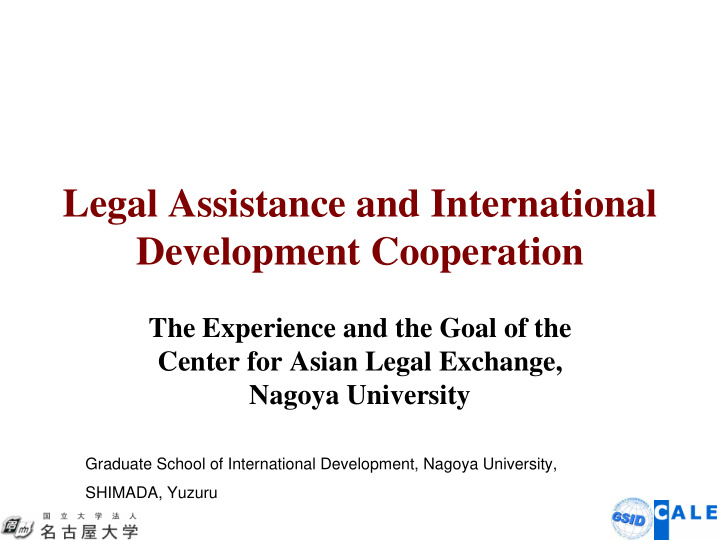



Legal Assistance and International Development Cooperation The Experience and the Goal of the Center for Asian Legal Exchange, Nagoya University Graduate School of International Development, Nagoya University, SHIMADA, Yuzuru
introduction Legal Assistance (International Cooperation in the Legal Field, Legal Technical Assistance…) Transitional countries Technical and Fair market economy Material Developing countries Rule of law Assistance for Human rights Countries in democratization Legal Reform Democracy Post-conflict countries Judicial Reform Drafting law Human resource development Legal infrastructure Election support
background Global context Nagoya university Transition to Market oriented system Economic globalization Academic cooperation Peace-building with Asian countries c.f. Revision of Japan’s ODA Charter (2003)
law and development (1) 1960s: “Development” & “Modernization” of the Third World Countries Law and Development Movement (LDM) Transplanting the US legal system Removing traditional barriers Change economic behavior Unilineal development view Underdevelopment = Backwardness Emulating the trajectory of western industrialized countries 1970s Ethnocentric conception Criticism of law
law and development (2) Post-LDM Dependency approach Distributive justice Law = tool for redistribution Neo-liberal market approach Strictly limit the state intervention to market Law = to protect private transaction and property rights Third World Jurisprudence & Legal Pluralism Correction of the ethnocentric conception of law
law and development (3) New Law and Development Movement (NLDM) End of the Cold War Globalization of market economy Theoretical characteristics Market will fail = Institutional reform Good Governance More than economic growth = Human security Practical characteristics Diverse donors (western countries, Japan, Korea, Competition among donors international organizations, NGOs, private law firms, academics) Ownership of recipient countries Diverse areas Conflicts between laws (legislation, judicial reform, legal infrastructure, human resource, election…)
Japan’s legal assistance (1) Cambodia Vietnam Laos Mongolia Uzbekistan Indonesia Final recommendation of the Justice Reform Council (2001) Legal assistance should be promoted Experience of the reception of western laws Revision of Japan’s ODA Charter (2003)
Japan’s legal assistance (2) Characteristics of Japanese assistance Consensus oriented Continuous deliberation with counterpart for consensus c.f. conditionality for WB’s loan Initiative of host countries (collaborative work) Counterpart L-T experts Domestic support committee Public sector-led enterprise Necessity of cooperation of academics and lawyers Confidence building as a same professionals Transfer the implicit know-how for institutional management
Nagoya university (1) AP project Academic cooperation International Symposium on Law (1990-) with Asian countries and politics in Asia (1998) Graduate School of Law CALE (2000-) Graduate School of International Development 2000-2001 within faculty Other institutions 2002- joint education facility “Legal Assistance for Asian Countries” project (2001-2006) Research grant by the MEXT Further development
Nagoya university (2) Agenda for the legal assistance Philosophy of the assistance, object countries and institutions, term of project Area of the legal assistance Coordination with other countries Possibility of Legal education in Japanese language Research Approach Critical appraisal of the LDM in 1960s Research on transition process to market oriented system Research on the legal culture and customary law in each country Integration of legal assistance study and international development study Gathering and dissemination of information
Nagoya university (3) Characteristic projects The role and influence of Research on Traditional Law and Legal traditional laws in the modern Culture legal reform Village laws in Vietnam ( huong uoc ) Utilizing to consolidate the rule of law Customary autonomous unit in Utilizing to consolidate the rule of law Uzbekistan ( Mahhallya )
Nagoya university (3) International Network Coordination and sharing experience in the legal assistance Partnership with Cornell, Wisconsin, and Lund (2006-) Broader network Domestic network of institutions International network with aid and cooperation agencies Cooperation network with institutions in Asian countries
Nagoya university (3) Education and Research Center for Japanese Law Problem of teaching language Limited number of English material on Japanese law Insufficient translation of laws (esp. contemporary laws) Education of Japanese language and Japanese law 4-5 years program Language training for practical research Japanese law study from 3rd year Utilizing network system and schooling (2 weeks in a year) Uzbekistan (2005), Mongolia (2006), and Vietnam (opened yesterday)
future agenda Distance between “Law” and “Development” in international cooperation Goal of legal assistance Development Legal assistance projects Strong emphasis on market economy Three factors in the international cooperation in the legal field Legal practitioner Identify and analyze Producing concrete problems in a given area, laws and implement Area expert focusing relation law legal reform and society Plan and set up comprehensive Program coordinator development program. Incorporate legal development project into overall program. Cooperation of Graduate school of law, and Role of University Graduate School of International development
Recommend
More recommend